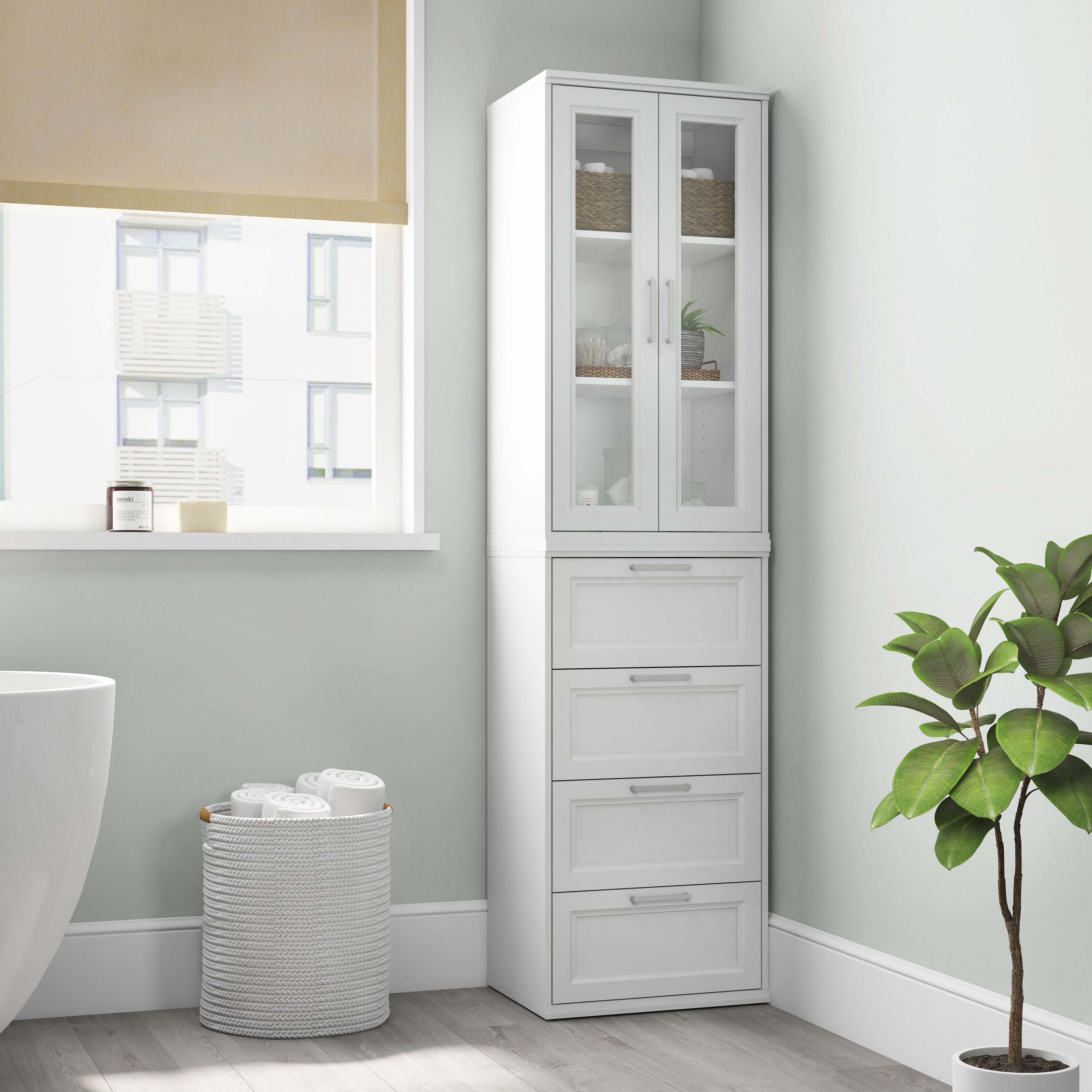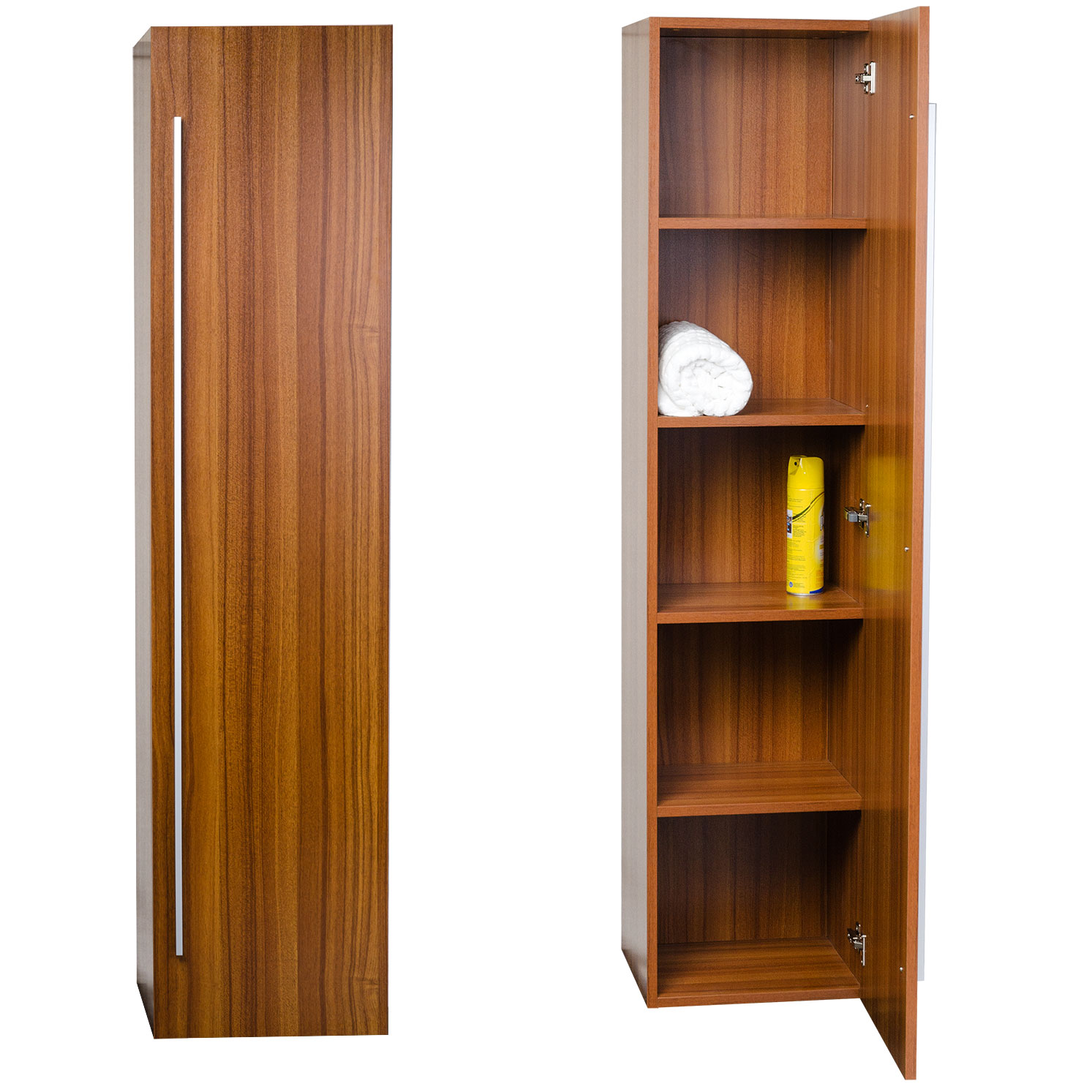Planning & Design for a DIY Built-in Linen Cabinet

Constructing a built-in linen cabinet offers a tailored storage solution for bathrooms of any size. Careful planning and design are crucial for a successful project, ensuring both functionality and aesthetic appeal. This section details the process, from initial measurements to style selection.
Linen Cabinet Layouts for Different Bathroom Sizes
Designing a linen cabinet requires consideration of the available space. Three layouts are presented below, tailored to small, medium, and large bathrooms. Dimensions are approximate and should be adjusted to suit individual needs and existing bathroom features.
- Small Bathroom (3ft x 4ft): A shallow cabinet (12 inches deep) with a single door, maximizing vertical space. Dimensions: 24 inches wide x 72 inches high x 12 inches deep. Materials: 1 sheet of ½ inch plywood, 1 door, hinges, handle, paint/stain.
- Medium Bathroom (5ft x 6ft): A double-doored cabinet with adjustable shelves, offering flexibility in storage. Dimensions: 36 inches wide x 72 inches high x 18 inches deep. Materials: 2 sheets of ½ inch plywood, 2 doors, hinges, handles, adjustable shelf supports, paint/stain.
- Large Bathroom (8ft x 10ft): A larger cabinet (24 inches deep) with multiple shelves and drawers, accommodating a wider range of items. Dimensions: 48 inches wide x 72 inches high x 24 inches deep. Materials: 3 sheets of ½ inch plywood, 2 doors, several drawers with slides, hinges, handles, adjustable shelf supports, paint/stain.
Accurately Measuring Space and Creating Construction Drawings
Precise measurements are paramount. Begin by measuring the designated wall space, noting any obstructions like plumbing pipes, electrical outlets, or existing fixtures. Use a measuring tape and level to ensure accuracy. Mark the location of these obstructions on your measurements. These measurements will inform the cabinet’s dimensions and placement. Construction drawings should include detailed dimensions (width, height, depth), shelf placement, door/drawer specifications, and the location of any necessary cutouts for plumbing or electrical work. These drawings serve as a blueprint for the construction phase. Consider using drafting software or sketching meticulously on graph paper to create clear, scaled drawings.
DIY Built-in Linen Cabinet Style Options
Three distinct styles are presented below, highlighting the materials and finishes that best suit each aesthetic.
| Style | Materials | Finish | Key Features |
|---|---|---|---|
| Modern Minimalist | Plywood, laminate | Clean, matte finish; possibly a light neutral color | Simple lines, flush doors, minimal hardware |
| Rustic Farmhouse | Reclaimed wood, beadboard | Distressed paint, natural wood stain | Visible wood grain, antique hardware, possibly open shelving |
| Traditional | Solid wood (oak, cherry), molding | Satin or gloss finish; possibly a dark, rich color | Ornate details, raised panel doors, decorative hardware |
Construction Techniques for a DIY Built-in Linen Cabinet
Building a custom built-in linen cabinet offers significant advantages over purchasing pre-fabricated units, allowing for precise tailoring to available space and personal aesthetic preferences. This section details the construction process, encompassing frame building, shelf and drawer installation, door integration, and finishing techniques.
Cabinet Frame Construction
The cabinet frame forms the foundation of the entire structure. Precise cuts and strong joinery are crucial for a sturdy and long-lasting cabinet. Begin by creating a detailed plan, including accurate measurements of the intended location. Cut the wood components (typically lumber like pine, plywood, or MDF) to the precise dimensions using a miter saw or circular saw, ensuring accuracy is paramount. For joinery, several options exist, each with its advantages and disadvantages. Dowel joinery offers strength and a clean aesthetic, requiring precise drilling and alignment of dowel holes. Pocket hole joinery, utilizing a jig, provides strong joints that are easily concealed. Biscuit joinery, using biscuit joiners, offers a simpler method for aligning boards, especially useful for larger panels. Once the pieces are cut, apply wood glue to the joining surfaces and assemble the frame. Clamps are essential to hold the pieces firmly in place while the glue dries. After the glue has cured, reinforce the joints with screws driven at an angle to minimize splitting.
Shelf, Drawer, and Door Installation
Once the frame is complete, shelves can be added. Measure the space and cut the shelf material to fit. Support the shelves using shelf pins, shelf supports, or cleats attached to the frame. For drawers, consider custom-sized units for optimal space utilization. Construct drawers from drawer slides and drawer fronts. Use appropriate drawer slides (e.g., full-extension, undermount) based on the desired functionality and weight capacity. Attach the drawer slides to both the drawer sides and the cabinet frame. The drawer fronts can be crafted from the same material as the cabinet frame or a contrasting material for a visually appealing effect. Doors are typically hung using hinges. Choose hinges appropriate for the door style and weight. Mortise hinges offer a concealed, elegant appearance, while surface-mounted hinges are simpler to install. Ensure the doors are properly aligned and close smoothly. Consider adding door handles or knobs for ease of access.
Finishing Techniques, Diy built in linen cabinet
The final step involves finishing the cabinet to enhance its appearance and durability. Several options are available, each offering unique characteristics. Painting provides a smooth, uniform finish, available in a wide range of colors. Preparation is key: sanding the wood smooth and applying a primer are essential for optimal adhesion and paint durability. Apply multiple coats of paint, allowing each coat to dry completely before applying the next. Staining allows the wood grain to show through, highlighting its natural beauty. Sand the wood smooth, then apply stain according to the manufacturer’s instructions. Several coats may be needed to achieve the desired depth of color. A sealant protects the finished surface from moisture and wear. Polyurethane is a popular choice, offering excellent durability and protection. Apply multiple coats, sanding lightly between coats for a smooth finish.
- Painting: Advantages: Wide color selection, hides imperfections; Disadvantages: Can obscure wood grain, requires careful preparation.
- Staining: Advantages: Shows wood grain, creates a natural look; Disadvantages: Can be messy, requires careful application, less durable than paint.
- Sealant (e.g., Polyurethane): Advantages: Protects against moisture and wear, enhances durability; Disadvantages: Can yellow over time (some types), requires careful application.
Advanced Features & Customization for a DIY Built-in Linen Cabinet: Diy Built In Linen Cabinet

Transforming a simple linen cabinet into a highly functional and personalized storage solution involves incorporating advanced features that enhance both its usability and aesthetic appeal. This section details the integration of such features, offering practical guidance for DIY enthusiasts.
Pull-Out Drawers and Adjustable Shelves
The addition of pull-out drawers and adjustable shelves significantly improves accessibility and organization within the linen cabinet. Pull-out drawers, particularly useful for storing smaller items like folded towels or undergarments, eliminate the need for deep reaching. Adjustable shelves, on the other hand, provide the flexibility to accommodate items of varying heights, maximizing storage capacity.
Installing pull-out drawer slides requires precise measurements and careful alignment. Standard full-extension slides are readily available at most hardware stores and are relatively easy to install. Tools required include a drill, screwdriver, level, measuring tape, and possibly a jigsaw for custom fitting. Ensure the drawer fronts are securely attached and the slides operate smoothly. For adjustable shelving, use shelf standards and brackets, ensuring that they are appropriately spaced and securely fastened to the cabinet’s interior.
Incorporating Hampers and Ironing Boards
Designing a built-in linen cabinet to accommodate additional storage solutions like hampers and ironing boards significantly enhances its practicality. A pull-out hamper can be seamlessly integrated into the cabinet’s design, using a similar system as the pull-out drawers. This can be a simple canvas bag mounted on drawer slides or a more sophisticated, built-in hamper with a hinged lid. For an ironing board, a dedicated space can be created within the cabinet, either by recessing the board into the cabinet or by creating a pull-out system.
Consider a cabinet design with dimensions of 72 inches high, 36 inches wide, and 12 inches deep. The lower third (24 inches) could house a pull-out hamper (20 inches wide, 10 inches deep, 18 inches high), leaving space above for a pull-out ironing board (20 inches wide, 10 inches deep, 18 inches high when extended). The upper two-thirds (48 inches) can be configured with adjustable shelves (12-inch depth) to accommodate linens and other items. The shelves can be adjusted in 1-inch increments using standard shelf pins.
Rewritten Article: Building Your Dream Linen Cabinet – A DIY Adventure
Forget those boring, mass-produced linen closets! Let’s build something truly special – a custom-designed, built-in linen cabinet that perfectly fits your space and style. Remember that time I tried to cram all my towels into a tiny closet? A disaster! That’s why I decided to take matters into my own hands.
This project is less daunting than you think. Start by planning the size and features. Do you need extra space for bulky blankets or a dedicated spot for your iron? Once you have a plan, gather your materials – sturdy wood, hinges, drawer slides, and all the fixings. The actual construction is a mix of cutting, assembling, and fine-tuning. Take your time, double-check measurements, and don’t be afraid to ask for help if needed. The reward? A beautiful, organized space that makes you smile every time you open the door. And hey, that’s way better than a cramped closet disaster!
